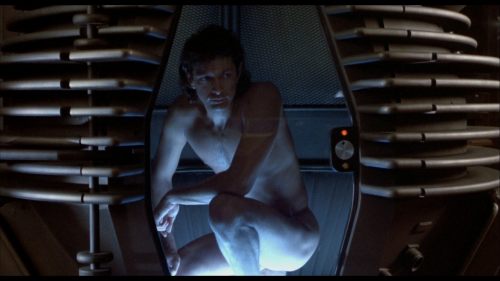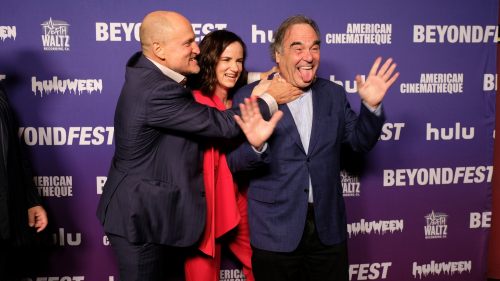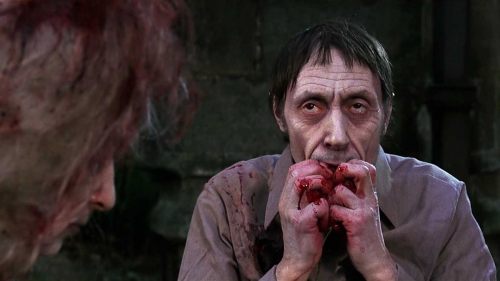Beyond Fest: David Cronenberg, An Actor’s Director
While speaking to The Japan Times in 2006 regarding David Cronenberg's A History of Violence, Maria Bello had this to say about the writer/director's approach to collaborating with his performers:
"David has an idea about the sort of people who would work well together. So, when he brought us together, he knew we had a similar vibe. We went over the script, every single scene, we got into our characters’ relationship, and the intricacies of the power struggle in their relationship. And then, he gave us room to play with that. So it’s not like we came to set every day and we knew exactly what we were gonna do. We had a structure, but there was an openness in there to play with it and see what it became. And that also has to do with trusting the other actor to take you to a place you hadn’t thought of."
Though it seems mildly redundant to point out, Cronenberg's movies require a certain level of artistic cohesiveness in every conceivable department in order to maintain what's arguably one of the most stylistically defined fingerprints in cinematic history. Many discuss his early movies in terms of their goopy, gross "body horror" aesthetics, while analyzing his later output (think: Dead Ringers and beyond) in terms of their more austere, mature "dramatic" themes (with the auteur’s chilly, formal precision being the great unifier between the two halves). Very rarely do we read about Cronenberg's methods for choosing and molding the most essential component of these pictures: the actors he's entrusted to help bring his often grotesquely wonderful filmic reveries to life.
In his AFI Harold Lloyd Master seminar, Cronenberg rather succinctly described how he views the process:
"I leave them alone, the actors...get good actors and then let them be good. It's true. Ralph Fiennes said that the directing he got on Spider was the least directing he got on any movie, and I took that as a huge compliment. It's not that you don't work with the actors, but a lot of it happens before you even get to set. You're talking to them about the character and asking questions...by the time Ralph came on the set, he had the character nailed. I didn't have to say anything. I followed him, really, and it becomes sort of like a documentary. Then, I feel like I'm shooting something I've discovered. It's like found art."
When viewed within the grand scheme of Cronenberg's filmography, Spider is the very definition of a "minor" movie, yet reveals so much about how the maturing Canadian shockmeister viewed the performers in his pieces. Every detail of the titular main character's existence is so thoroughly lived-in that, had the lead not owned Fiennes’ familiar mug, we'd probably think that Cronenberg did in fact recruit some mentally disturbed street person and just decided to document their days. Though the final payoff is a touch underwhelming, the majority of Spider finds Fiennes' mumbling, stuttering damaged man wandering through his own memory, desperately searching for a truth about his current state that he's been hiding even from himself (via years of repression).
For their "Cronenberg With Cronenberg" retrospective, Beyond Fest paired Spider with the director's most controversial film: the obliquely erotic sex and car wrecks masterpiece, Crash. On the surface, this double bill doesn't make a whole lot of sense, but when watching the movies back-to-back, Cronenberg's theory of attempting to manufacture "found art" is on full display. Based on the novel by J.G. Ballard, Crash follows a sexually promiscuous television director (a truly alien James Spader) and his partner (an equally otherworldly Deborah Kara Unger) as they're inducted into a secret society that derives pleasure from the "fertilizing" nature of automobile accidents. What follows is a metallically sensual journey, as Ballard is taken under the wing of the mysterious Vaughan (Elias Koteas), who recreates the tragic deaths of movie stars such as James Dean and Jayne Mansfield for his captive, aroused audience's delight.
Though the two leads are almost defined by their detachment and speak in constant cryptic whispers, Cronenberg uses Spader and Kara Unger's characters as hand-holding guides into this often baffling underworld. These are primal explorers of corporeal experience, and the level of trust Cronenberg had to inspire in his performers in order for them to bring this clinical dissection to life is difficult to even comprehend. There are numerous sex scenes (some involving wounds acting as new orifices), as cinematographer Peter Suschitzky’s camera leers at leg and back braces, as if they're dominatrix gear. Nevertheless, the entire cast (which also includes Holly Hunter and Rosanna Arquette) commit to the film’s fetishistic nature in such a way that it feels like Cronenberg has stumbled upon an entirely new breed of human sexuality.
Interestingly enough, while Cronenberg gathered a cadre of character actors (Joe Silver, Robert Silverman, Les Carlson) who would regularly appear in his earliest works, he rarely teams with the same leading men and women on multiple occasions (and when he does, it seems like the number of repeat collaborations is capped at three). Viggo Mortensen found a solid rapport with the director in two movies about identity (A History of Violence and Eastern Promises), and another about the psychology of sex (A Dangerous Method). Robert Pattinson signed on for the auteur’s last two outlandish experiments (Cosmopolis and Maps to the Stars). Jeremy Irons gave what's arguably the finest (dual) performance in his career with Dead Ringers (though he wouldn't win an Academy Award until his 1990 role in Reversal of Fortune), before appearing in possibly the most undervalued entry in Cronenberg's body of work (M. Butterfly).
However, the finest instance of pairing performers and material that Cronenberg's ever pulled off is casting Jeff Goldblum and Geena Davis in The Fly. A re-imagining of the late '50s sci-fi B-Movie staple (where a scientist accidentally splices his own DNA with a common housefly's), the real power of the movie comes from Goldblum and Davis (who were in the throes of their real life premarital passion) selling us on the relationship between mad scientist Seth Brundle and Particle magazine reporter Veronica Quaife. Imagined as an opera (complete with one of Howard Shore's greatest scores), our former man of horror Phil Nobile Jr. once commented on the movie's condensed relationship cycle:
"The Fly deals with Cronenberg’s career-long conundrum [the inevitability of death] from a unique, emotional angle; while his protagonist is running through his arc of transformation, Cronenberg is also examining the nightmarish journey of what it’s like to be in love with someone who is slowly becoming someone else. And often overlooked in the wake of Jeff Goldblum’s amazing performance as Seth Brundle is Geena Davis’ layered, nuanced turn as Veronica Quaife. In a tight 90 minutes, Davis delivers as thorough a relationship arc as you’re likely to find, touching on themes of new love, betrayal, domestic violence, abortion issues and the assisted suicide of a life partner. It’s an incredible performance, and much more complex than was often credited upon release."
This exploration of love in The Fly reverberates with same creative ethos Cronenberg later laid out when discussing Spider: "get good actors and then let them be good." Goldblum and Davis were perfect for Seth and Veronica, just in the same way that Fiennes was perfect for Spider, Irons was the ideal choice for the Mantle twins, Mortensen slipped into the skins of two men of violence, and so on and so forth. Cronenberg's design for delivering performance adheres to the age old Hollywood adage that casting is 90% of the battle when trying to make your movie come to life, and his gentle, scientifically observant nature allows the actors to exist inside of their roles with ease and grace. For an artist known for executing such an exacting style, it's actually Cronenberg's relative looseness that truly lets his characters (and those playing them) shine through.
Spider was presented on glorious 35mm as the final film in Beyond Fest's "Cronenberg With Cronenberg" retrospective.



